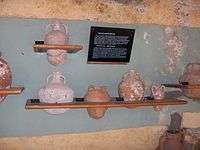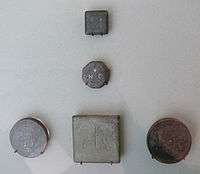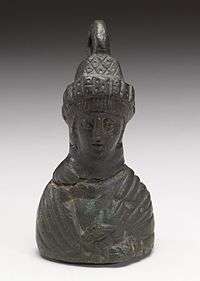Byzantine units of measurement
Byzantine units of measurement were a combination and modification of the ancient Greek and Roman units of measurement used in the Byzantine Empire.
Until the reign of Justinian I (527–565), no universal system of units of measurement existed in the Byzantine world, and each region used its traditional measures. Justinian began the process of standardization that resulted in a specifically Byzantine system, chiefly due to the need of such a system for the fiscal administration.[1] Official measurement and weighing was performed subject to an array of charges including the mestikon, miniatikon, zygastikon, kambaniatikon, gomariatikon, and samariatikon.[2] Despite the central government's insistence on the use of official measures, other systems continued to be used in parallel, whether due to local traditions or foreign influences, or in order to cover the necessities of specific trades or crafts.[1] In addition, from the 12th century, foreign merchants such as the Venetians, Pisans, and Genovese operating within the Empire received the right to use their own systems.[1][2]
Length
The Byzantine Empire continued to employ the anthropometric units used by the Greeks and Romans.
Weights and measures acts were sometimes undertaken by the emperors as forms of tax reform. An 11th-century guide to Byzantine tax collection contains emendations concerning the Emperor Michael's[n 1] addition of a palm to the fathom used in computing the schoinion,[n 2] an act which reduced the holders' taxable area by about 5%.
| Unit | Greek name | Greek feet | meters | Notes |
|---|---|---|---|---|
| Digit (Finger) | dáktylos (δάκτυλος) | 1⁄16 | 0.0195 | also called monas (μονάς), "unit", as the smallest unit of length.[6] |
| Palm | palaistḗ (παλαιστή) anticheir (αντιχειρ) [3] |
1⁄4 | 0.0787 | |
| Half-pous Half-foot | hēmipódion (ἡμιπόδιον) | 1⁄2 | 0.1574 | |
| Span | spithamḗ (σπιθαμή) | 3⁄4 | 0.2361 | |
| Pous (Foot) | poûs (ποῦς) | 1 | 0.3123 | Derived from the ancient Greek foot, the standard foot length in Byzantium seems to have been 0.3123 m, but in practice the length fluctuated between 0.308 and 0.320 m[7] |
| Public Cubit | dêmosios pêkhys (δημόσιος πῆχυς) | 1 1⁄3 | 0.4688 | lit. "forearm" The Public Cubit counted 24 daktyloi and was used mainly in construction, hence was also called lithikos ("stone"), [xylo]pristikos ("[wood]-sawing"), tektonikos ("builder's").[6] The Imperial or Geometric Cubit counted 32 daktyloi and was used for the measurement of fields for the purpose of tax assessment.[6] Local variants also existed for various other commodities.[6] |
| Imperial or Geometric Cubit | basilikos/geômetrikos pêkhys (βασιλικός/γεωμετρικός πῆχυς) | 2 | 0.625 | |
| (Single) Pace | bêma haploûn (βῆμα ἁπλοῦν) | 2 1⁄2 | 0.787 | (=English pace) |
| Double pace | bêma diploûn (βῆμα διπλοῦν) | 5 | 1.574 | (=Roman pace) |
| Simple Orguia (Simple) Fathom | haplê orguiá (ἁπλὴ ὀργυιά) | 6 | 1.87 | Derived from the equivalent ancient Greek unit (1.89 m)[8] From the 14th century on local variants also existed, often called kanna from the Italian canna.[8] |
| Imperial or Geometric Orguia Imperial or Geometric Fathom | basilikê/geômetrikê orguiá (βασιλικὴ/γεωμετρικὴ ὀργυιά) | 6 3⁄4 | 2.10 | 9 spithamai = 108 daktyloi, used for the measurement of fields for the purpose of tax assessment. To ease the farmers' tax burden, Michael IV introduced a longer version of 9.25 spithamai (2.17 m) for use in middle and high quality, while the lower value was retained for poorer fields.[8] |
| Perch | dekápodon (δεκάποδον) | 10 | 3.148 | lit. "decafoot: 10-foot [length]" |
| Schoinion | skhoinion (σχοινιον) | 60 72 |
21.30 25.30[9] |
lit. "little schoenus" The basis of land tax assessments, variously reckoned as 10 fathoms in the fertile Balkan and west Anatolian themes and as 12 in the rest of Asia Minor.[9] |
| Plethron | pléthron (πλέθρον) | 100 | 31.48 | The Greek furlong, one side of the ancient Greek acre[10] Uncommon in Byzantine texts[11] |
| Stade | stádion (στάδιον) | 600 | 188.8 | Also stadion or stadium (pl. stadia) (=English furlong) |
| Bowshot | doxarioú bolḗ (δοξαριού βολή) | 1000 | 314.8 | |
| Mile | mílion (μίλιον) | 5000 | 1574 | Also milion (=Roman mile) |
| Schoenus | skhoinos (σχοινος) | 20000 | 6296 | lit. "reed rope" 33 1⁄3 stades, against various (usually longer) classical values |
| Day's Journey | hodós hēméras (ὁδός ἡμέρας) | 150000 | 47220 | |
| Week's Journey | hodós sabbátou (ὁδός σαββάτου) | 1050000 | 330540 | |
| Source: Loizos,[12] unless otherwise noted. Metric equivalents are approximate. | ||||
Area
The ordinary units used for land measurement were Greek.
| Unit | Greek name | square Greek feet | square meters | Notes | |
|---|---|---|---|---|---|
| (Square) Pous (square foot) | poûs (ποῦς) | 1 | 0.095 | ||
| Stremma | strémma (στρέμμα) | 10000 | 991 | lit. "turning" Sometimes described as a (square) "plethron",[13] although this is uncommon in Byzantine texts[11] The ancient Greek acre, originally defined by the distance plowed by a team of oxen in a day[10] and continuing to vary according to land quality under the Byzantines between 900 and 1900 m2[14] | |
| Modios Zeugarion | módios (μόδιος) zeugárion (ζευγάριον) |
30000 | 2973 | Highly variable. Modioi were sometimes much smaller units that might come 100 or 250 to a single zeugarion.[15] The "Modion" was originally a grain measure, and "zeugarion" referred to a yoke.[1] | |
| Source: Loizos,[13] unless otherwise noted. Metric equivalents are approximate. | |||||
Volume

The ordinary units used for liquid measurement were mostly Roman:
| Unit | Greek name | Litras | liters | Notes | ||
|---|---|---|---|---|---|---|
| (Liquid) Ounce | ouggía (οὐγγία) ogkía (ὀγκία) ougkía (οὐγκία) |
1⁄12 | 0.1824 | (=Roman uncia) | ||
| Cotyla Half-xesta |
kotýlē (κοτύλη) hēmixéstion (ἡμιξέστιον) |
1⁄8 | 0.276 | (=Roman half-sextarius) | ||
| Xesta | xéstēs (ξέστης) | 1⁄4 | 0.548 | (=Roman sextarius) | ||
| (Liquid) Litra (Liter) |
lítra (λίτρα) | 1 | 2.1888 | (=Roman libra) | ||
| Handful | phoûkta (φοῦκτα) | 1 13⁄24 | 3.367 | |||
| (Liquid) Modios | módios (μόδιος) | 40 | 87.552 | |||
| Source: Loizos,[16] unless otherwise noted. Metric equivalents are approximate. | ||||||
Weight

The ordinary units used for measurement of weight or mass were mostly Roman, based on the late Roman pound.[18] This has been reconstructed on the basis of known legislation of Constantine the Great in AD 309 establishing 72 gold solidi (Greek: νόμισμα, nómisma) to the pound. As the early solidi weighed 4.55 g, the pound was therefore 0.3276 kg at the time.[18] The solidus was repeatedly debased, however, implying average pounds of 0.324 kg (4th–6th century), 0.322 kg (6th–7th century), 0.320 kg (7th–9th century), 0.319 kg (9th–13th century), and even less thereafter.[18]
Model weights were made in lead, bronze, and glass and (less often) from gold and silver.[19] They came in various styles. Presently, archaeologists believe the bronze spheres sliced flat at top and bottom and marked with an omicron/upsilon date from the early 3rd to late 5th centuries, gradually being replaced by cubes marked with a gamma/omicron (𐆄) over the course of the 4th century.[19] In the second half of the 6th century, these were replaced by discs until at least the early 9th century[19] and possibly the 12th.[20] The glass weights had numerous advantages in manufacture and use[20] but seem to have disappeared following the loss of the empire's Syrian and Egyptian provinces in the 7th century.[21]
Analysis of the thousands of surviving model weights strongly suggest multiple local weight standards in the Byzantine Empire before the Arab conquests.[22] Under Justinian, the weights of currency were administered by the comes sacrarum largitionum and commodity weights by the praetorian prefect and eparch of the city.[23] By the 9th century, the eparch nominally controlled all official weights in Constantinople,[19][24] although archaeology has shown others issued their own weights, including proconsuls, viri laudabiles, and viri clarissimi in the west and anthypatoi, counts, and ephors in the east.[19]
| Unit | Greek name | Greek ounces | grams | Notes | ||
|---|---|---|---|---|---|---|
| Scruple | gramma (γραμμα) trēmísis (τρημίσις) |
1⁄24 | 1.55[21] | |||
| Semissis | sēmísis (σημίσις) | 1⁄12 | 2.27[20] | |||
| Nomisma | nómisma (νόμισμα) | 1⁄6 | 4.55 | |||
| Ounce | ouggía (οὐγγία)[25] ogkía (ὀγκία)[25] ougkía (οὐγκία)[25] |
1 | 27.3 | (=Roman uncia) | ||
| Litra (Pound) |
lítra (λίτρα) | 12 | 327.6[18] | Value c. 309, but diminishing over time.[18] (=Roman pound) | ||
| Source: Loizos,[26] unless otherwise noted. Metric equivalents are approximate. | ||||||
See also
- Greek units
- Roman units
Notes
- Probably but not certainly Michael IV (r. 1034–1041).[3]
- The text survives in a 14th-century copy[4] but is dated from its internal evidence.[5]
References
Citations
- ODB, "Measures" (E. Schilbach), pp. 1325–1326.
- Oikonomides (2002), p. 1052.
- Oikonomides (2002), p. 976.
- Codex Parisinus supplementus graecus 676. 14th century.
- Oikonomides (2002), p. 975.
- ODB, "Daktylos" (E. Schilbach), p. 578.
- ODB, "Pous" (E. Schilbach), p. 1708.
- ODB, "Orgyia" (E. Schilbach, A. Cutler), pp. 1532–1533.
- Oikonomides (2002), p. 996.
- Pryce (2012).
- Schilbach (1991).
- Loizos (2010), p. 1–2.
- Loizos (2010), p. 3.
- Davis (2004).
- Krumbacher (1998), p. 176.
- Loizos (2010), p. 4.
- Marlia Mundell Mango (2009). Byzantine Trade, 4th-12th Centuries: The Archaeology of Local, Regional and International Exchange : Papers of the Thirty-eighth Spring Symposium of Byzantine Studies, St John's CollegeUniversity of Oxford, March 2004. Ashgate Publishing, Ltd. p. 73. ISBN 978-0-7546-6310-2.
- Entwistle (2002), p. 611.
- Entwistle (2002), p. 612.
- Entwistle (2002), p. 613.
- Entwistle (2002), p. 614.
- Entwistle (2002), pp. 611 & 613.
- Code of Justinian, Novel 128, Ch. 15.[19]
- Nicole (1970), pp. 32, 45, 47–48, & 56.
- Smith.
- Loizos (2010), p. 5.
Bibliography
- Davis, Siriol (2004), "Pylos Regional Archaeological Project, Part VI: Administration and Settlement in Venetian Navarino", Hesperia.
- Entwistle, Christopher (2002), "Byzantine Weights", The Economic History of Byzantium: From the Seventh through the Fifteenth Century, Washington: Dumbarton Oaks.
- Kazhdan, Alexander, ed. (1991). The Oxford Dictionary of Byzantium. Oxford University Press. ISBN 978-0-19-504652-6. Missing or empty
|title=(help) - Krumbacher, Karl, ed. (1998), Byzantinische Zeitschrift, Vol. XCI, De Gruyter, p. 176.
- Loizos, Demetris I. (2010), "Byzantine Measures" (PDF), Digital Humanities: Diophant Ancient Measures Converter, retrieved 6 April 2015.
- Morrisson, Cécile; et al. (2002), "Prices and Wages in the Byzantine World", The Economic History of Byzantium: From the Seventh through the Fifteenth Century, Washington: Dumbarton Oaks, pp. 815–878.
- Nicole, J., ed. (1970), The Book of the Eparch, London.
- Oikonomides, Nicolas (2002), "The Role of the Byzantine State in the Economy", The Economic History of Byzantium: From the Seventh through the Fifteenth Century, Translated for publication by John Solman, Washington: Dumbarton Oaks, pp. 973–1058.
- Porter, H. (1939), "Sabbath Day's Journey", International Standard Bible Encyclopedia, William B. Eerdmans Publishing.
- Pryce, Frederick Norman; et al. (2012), "measures", The Oxford Classical Dictionary, 4th ed., Oxford: Oxford University Press, p. 917, ISBN 978-0-19-954556-8.
- Schilbach, Erich (1991), "Pletron", The Oxford Dictionary of Byzantium, Oxford: Oxford University Press, ISBN 9780195046526.
- Smith, William (ed.), "Uncia", A Dictionary of Greek and Roman Antiquities, p. 1213

